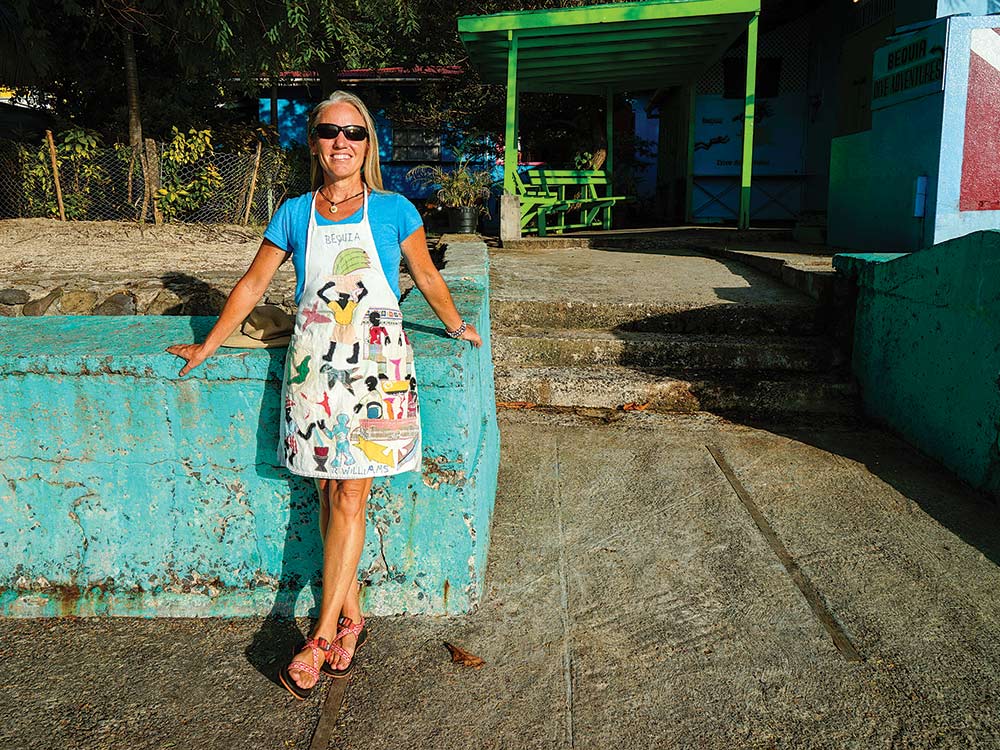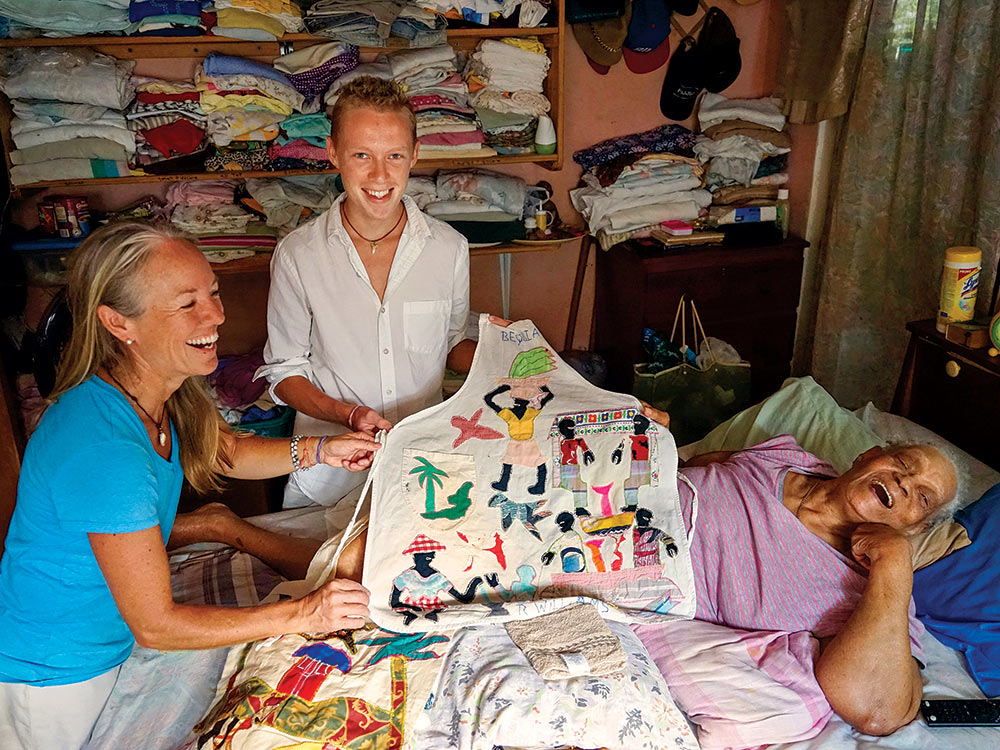
Boards were missing from a rickety dinghy dock where cruisers tie up upon arrival to Bequia‘s Admiralty Bay. Last year’s devastating hurricane season wasn’t to blame; peeling paint and weathered shingles nearby tell a bigger story of long-term inattention. An older man with varicose-rippled legs, the left one encumbered by edema, limped down the pier with a greeting. “Do you know Tango?” he asked.
Well, we did now, as that’s how he introduced himself. His gray coils sprung away from a friendly face that was sprightlier than the rest of his form. Tango was the first step in what I anticipated to be a challenging quest on Bequia: to find the identity of “R. Williams,” and meet him or her if possible.
Worked in bright colors on a base of cotton sackcloth, it might not sound special, but this apron is one of my prized possessions.
Who is R. Williams? I didn’t know, but the name is stitched at the bottom of an apron I’ve had for a couple of decades. Spelled in zigzag at the top is “BEQUIA,” and between these sewn letters are appliqued shapes and figures that tell the story of everyday life on a small Caribbean island: people cooking and working, a pair of birds swirling next to a silhouette of the island, fish tempted by the fisherman’s hook. Worked in bright colors on a base of cotton sackcloth, it might not sound special, but this apron is one of my treasured possessions. Its vivid folk art captures the imagination: images telling a kind of sepia-tinted, idealized view of a simple life in the tropics. For years before our cruising adventures on Totem started, it was a reminder of our plans. Someday we’d get to Bequia, and maybe we’d even see people carrying banana stalks on their heads, standing to pound grain in a tall mortar or fishing from a pointy-stern boat.
We had only two days to stop at Bequia on our northbound track to meet a flight my husband, Jamie, needed to catch from Martinique the following week. Two days to soak in an island with a prized reputation among cruisers, treasured for clear water, lush hillsides and beautiful beaches. But it was two days that I could spend focused on looking for this apron artist if that was all I had.
Tango pointed to the fresh fruit-and-vegetable market. “Mebbe dey know dis R. Williams.”
A fruit seller plied me with honey-sweet slices of juicy mango, then sent me to the craft bazaar. Once there, I was directed to a pair of older women at an inner stall. For a few minutes, they clucked over the design, turning the apron over in their hands, then stunned me by saying, matter-of-factly, “This here is Rita Williams’ work.” The women went on to describe exactly where I could find Rita, a short walk away to the south side of the village. Less than 30 minutes after reaching the shore, I was standing outside her place, thrilled and a little anxious.
Meeting Rita opened a window through a tourist economy into life on Bequia. Led down a shell-and-gravel path to her home behind the family-run bar and restaurant, I was ushered into Rita’s room. Bedridden since her foot was amputated a few years back, her world fits into a 10-by-10-foot space lined with packed shelves and a cupboard, with a TV for company and her extended family on call. Sitting with her, telling her what her apron meant to me, I was gifted with stories she told of her life. These stories started with the patterns in the apron and grew into the stories of Bequia. The work she and her husband have done over the years centered on the vacationers coming to their island home. Rita’s stories continued with how the geography of the village had changed, what the local government did to help, what the schools are like, problems with youth and her disappointment that “de young people” have abandoned this handiwork that she made a living from. Rita shared the meaning behind each of the appliques: fishermen weaving tales on the water, villagers meeting with news, women carrying provisions. What I thought was a mortar is actually a coal pot for cooking, with whale flesh inside — Bequia remains one of the few countries granted a waiver by the International Whaling Commission. Inwardly, I cringed with the thought of whale killing, while Rita told of islandwide celebrations after a successful humpback hunt.

Listening to Rita reminded me of other personal connections that provided lessons in local life. In Malaysia, we spoke into the night with a Chinese-Malaysian business owner. We learned about everything from his hopes for his children and the challenges they face to the systematic discrimination against this ethnicity that makes up a quarter of Malaysia’s population. In Papua New Guinea, it was the many ways that communities are locked into poverty without opportunity, which stemmed from a long discussion in our Totem’s cockpit with a man from the island off of which we anchored. Conversations with South Africans from different backgrounds hammered home the complexities of education and race and justice that hinder that beautiful country.
As I sat in the close space of Rita’s room, I couldn’t regret how much of the Bequia we’re “supposed” to see but had to miss. With our limited time, there was no hike to Bequia Head or Peggy’s Rock. No truck-bus to the turtle hatchery. No snorkeling on the lobster nursery. We passed up the waterfront restaurants, although with a longing eye (buffet dinner with a tin-pan band cost more than a week’s groceries for our family). Connections like this with R. Williams bring a much deeper meaning to a place.
I brought the rest of my family back to meet Rita the following day. While the sun sank behind Bequia’s fertile hills, Rita again illuminated the stories in the apron. Her words brought us an unforgettable, human side to the culture of this island. “I’m so glad you found me still alive,” she said. So am I.
Behan Gifford and her family have spent the past 10 years sailing around the world aboard Totem, their Stevens 47. Follow the family’s adventures at sailingtotem.com.








